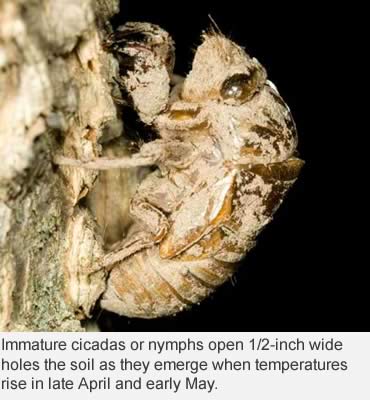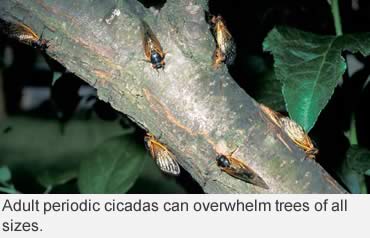Photo: Red-eyed, black-bodied periodical cicadas emerge in large broods every 13 to 17 years, depending on the specific brood and location.
If you missed the huge emergence of 13-year cicadas in 2011 because they were not present in the area where you live, you may have another opportunity this year.
Two other broods of periodical cicadas will emerge this spring, and in places not included in the 2011 emergence.
According to the Periodical Cicada Mapping Project (www.magicicada.org), 2015 will be an outstanding year for periodical cicadas when two broods emerge.
The 13-year Brood XXIII (known as the Mississippian Brood) and 17-year Brood IV (called the Kansan Brood) will both arrive this spring.
 Currently there are 7 recognized species of periodical cicadas, 12 distinct 17-year broods, and 3 distinct 13-year broods, along with 2 known extinct broods, that are found east of the Great Plains and south of the Great Lakes, to the Florida Panhandle.
Currently there are 7 recognized species of periodical cicadas, 12 distinct 17-year broods, and 3 distinct 13-year broods, along with 2 known extinct broods, that are found east of the Great Plains and south of the Great Lakes, to the Florida Panhandle.
A brood of 17-year cicadas (Brood IV) that inhabits an area extending from Iowa to Texas will emerge in northwestern and western Missouri.
A separate brood of 13-year cicadas (Brood XXIII) that extends from Illinois to Louisiana will emerge in southeastern Missouri.
In Missouri, periodical cicadas are expected to emerge from the soil in mid-May, but the timing could change depending on how quickly spring weather warms up.
Prior to emerging, cicada nymphs open up half-inch diameter holes in the soil. Some of the holes are topped with chimney-like mud towers. A few days after emerging males begin their noisy “singing” to attract mates.
The most visible impact from a periodical cicada emergence occurs on trees when females cut slits into 1/4 to 1/2-inch diameter twigs where they deposit their eggs. Leaves on damaged twigs turn brown, and some twigs may die. The effect on mature trees is minor.
Small trees can be protected by placing netting with mesh smaller than 1/4 inch over branches and tying it closed on the trunk. No insecticide use is recommended.
 Periodical cicadas emerge as broods every 13 or 17 years, depending on the brood. Mass emergences can range over several states. They generally start emerging in May and remain above ground through most of June.
Periodical cicadas emerge as broods every 13 or 17 years, depending on the brood. Mass emergences can range over several states. They generally start emerging in May and remain above ground through most of June.
Dog Day or annual cicadas are the more well known cicadas. During the heat of late summer months, annual cicadas emerge and make their presence known with a distinctive droning noise.
The enormous number of cicadas—periodical and annual—that emerge at one time often swamps birds and other cicada predators with more juicy insect food than they can consume. This allows most of the cicadas in the brood to survive and produce another generation that will live in the ground for the next 13 or 17 years.
The key differences between periodical and annual cicadas are body colors and time of emergence.
To learn more about annual cicadas, visit the Great Plains Nature Center, Wichita, Kan.
For more information on periodical cicada emergence, other cicada links and the mapping project conducted by Dr. John Cooley for Magiciada.org., visit www.magicicada.org.
Contributors: Missouri Department of Conservation, the Periodical Cicadas Mapping Project, the Great Plains Nature Center.
– Photos courtesy Missouri Department of Conservation